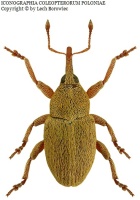Підтримуємо Вільну Україну
 We Support Free Ukraine
We Support Free Ukraine

Biodiversity Map
Taxa

-
Arthropodaphylum
Click to switch
to select orders
and filters > -
Hexapodasubphylum
Click to switch
to select orders
and filters > -
Insectaclass
Click to switch
to select orders
and filters > -
Coleopteraorder
Click to set
as the main taxon
and as a base
← of the left panel > -
Polyphagasuborder
Click to set
as the main taxon
and as a base
← of the left panel > -
Cucujiformiaseries
Click to set
as the main taxon
and as a base
← of the left panel > -
Curculionoideasuperfamily
Click to set
as the main taxon
and as a base
← of the left panel > -
Curculionidaefamily
Click to set
as the main taxon
and as a base
← of the left panel > -
Curculioninaesubfamily
Click to set
as the main taxon
and as a base
← of the left panel > -
Tychiinitribe
Click to set
as the main taxon
and as a base
← of the left panel > -
Tychiusgenus
Click to set
as the main taxon
and as a base
← of the left panel >
species:
Tychius aureolus
PL
YES
name status: valid name
BioMap ID: 1046462
taxon code: 5291
taxonomy checked: YES
Data on distribution in Poland

Statistics
- Records: 321
- Publications: 86
- Collections: 8
- Publication authors: 56
- Illustrations (iconography): 1
- Photos (specimen/observation): lacking
Taxon description
Gatunek obejmujący zasięgiem południową i środkową część Europy; notowany poza tym z Azji Mniejszej. W Polsce, chociaż nie jest jeszcze znany z niektórych krain, występuje prawdopodobnie w całym kraju z wyjątkiem wyższych partii górskich. Na ogół jest notowany z nielicznych stanowisk w poszczególnych krainach, tylko z Wyżyny Lubelskiej wykazany z wielu miejscowości. Zamieszkuje suche i ciepłe środowiska. Żyje na lucernie siewnej — Medicago sativa L., lucernie sierpowatej — M. falcata L. i koniczynie łąkowej — Trifolium pratense L. Postacie dojrzałe ukazują się na początku maja na roślinach, na których przebywają do połowy sierpnia. Larwy odżywiają się niedojrzałymi owocami. Rozwój larwalny trwa około 2-3 tygodni. Na przepoczwarczenie larwy przechodzą do gleby. Stadium poczwarki trwa około 3 tygodni. Nowe pokolenie pojawia się w sierpniu i prawdopodobnie zimuje w komorach poczwarkowych.
Illustrations
... browse
 Tychius
Tychiusaureolus
External data sources
- Ostatnie rekordy
-
1027784
 ×
× Curculionidae: Tychius aureolus, PL, Podlasie, Biebrzański P.N., podlaskie, Biebrzański P.N., Basen Południowy buffer zone, 1996, leg. M. Wanat (Wanat 2005d)
Curculionidae: Tychius aureolus, PL, Podlasie, Biebrzański P.N., podlaskie, Biebrzański P.N., Basen Południowy buffer zone, 1996, leg. M. Wanat (Wanat 2005d) -
1027478
 ×
× Curculionidae: Tychius aureolus, PL, Pojezierze Mazurskie, Biebrzański P.N., podlaskie, Biebrzański P.N., Basen Środkowy buffer zone, 1996, leg. M. Wanat (Wanat 2005d)
Curculionidae: Tychius aureolus, PL, Pojezierze Mazurskie, Biebrzański P.N., podlaskie, Biebrzański P.N., Basen Środkowy buffer zone, 1996, leg. M. Wanat (Wanat 2005d) -
807634
 ⊡
⊡ Curculionidae: Tychius aureolus, PL, Beskid Zachodni, Beskid Sądecki, Wierchomla Mała, UTM DV87, 2010, leg. T. Wojas
Curculionidae: Tychius aureolus, PL, Beskid Zachodni, Beskid Sądecki, Wierchomla Mała, UTM DV87, 2010, leg. T. Wojas -
807246
 ⊡
⊡ Curculionidae: Tychius aureolus, PL, Wyżyna Krakowsko-Wieluńska, Kraków, Tyniec, UTM DA14, 2009, leg. T. Wojas
Curculionidae: Tychius aureolus, PL, Wyżyna Krakowsko-Wieluńska, Kraków, Tyniec, UTM DA14, 2009, leg. T. Wojas -
801602
 ×
× Curculionidae: Tychius aureolus, PL (Mazur 2011c)
Curculionidae: Tychius aureolus, PL (Mazur 2011c) -
801601
 ×
× Curculionidae: Tychius aureolus, PL (Maciejowski 2007)
Curculionidae: Tychius aureolus, PL (Maciejowski 2007) -
801600
 ×
× Curculionidae: Tychius aureolus, PL (Kubisz et al. 1998b)
Curculionidae: Tychius aureolus, PL (Kubisz et al. 1998b) -
801599
 ×
× Curculionidae: Tychius aureolus, PL (Jaskuła et al. 2009a)
Curculionidae: Tychius aureolus, PL (Jaskuła et al. 2009a) -
801598
 ×
× Curculionidae: Tychius aureolus, PL (Pawłowski et Kubisz 2008)
Curculionidae: Tychius aureolus, PL (Pawłowski et Kubisz 2008) -
801597
 ×
× Curculionidae: Tychius aureolus, PL (Renner et Messutat 2007)
Curculionidae: Tychius aureolus, PL (Renner et Messutat 2007) - ... more
- Powiązane publikacje
-
Mazur M.A. 2011c. Weevils (Coleoptera: Curculionoidea) of the Stobrawski Landscape Park. Pol. Pismo Ent., 80(2):321-342.
 full text
full text Show records
Show records -
Jaskuła R., Przewoźny M., Melke A. 2009a. Chrząszcze (Coleoptera). [In:] Jaskuła R., Tończyk G. (Eds.) Owady (Insecta) Spalskiego Parku Krajobrazowego, Część I. Mazowiecko-Świętokrzyskie Towarzystwo Ornitologiczne, Spała. pp. 27-59.
 Show records
Show records -
Pawłowski J.S., Kubisz D. 2008. Chrząszcze Ojcowskiego Parku Narodowego i otuliny. [In:] Klasa A., Partyka J. (Eds.) Monografia Ojcowskiego Parku Narodowego. Przyroda. Ojców. pp. 553-576.
 Show records
Show records -
Ruta R. 2007. Chrząszcze (Insecta: Coleoptera) kserotermicznych wzgórz Byszewickich w Dolinie Noteci. Nowy Pam. Fizjogr., 5:49-107.
 Show records
Show records -
Renner K., Messutat J. 2007. Untersuchungen zur Käferfauna der Umgebung von Skwierzyna im westlichen Polen (Wielkopolska). Coleo, 8:16-20.
 Show records
Show records - ... more
- Powiązane zbiory
-
ISEZ PAN
 Show records
Show records -
Kuśka A.*
 Show records
Show records -
Muz. Górnośląskie, Bytom: Mączyński
 Show records
Show records -
Wanat M.*
 Show records
Show records -
Mazur M.A.
 Show records
Show records - ... more
- Wykaz powiązanych pozycji
-
Curculionoidea of Poland
 Show records
Show records




